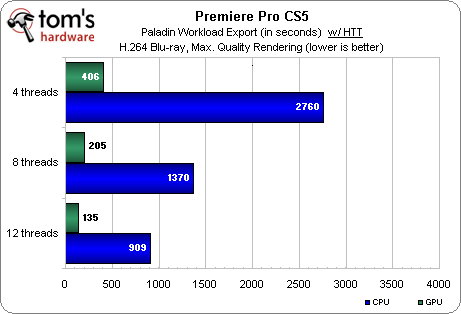Adobe CS5: 64-bit, CUDA-Accelerated, And Threaded Performance
Conclusion
CUDA is not a cure-all. As our tests showed, there are clearly some tests that showcase CUDA’s benefits more than others. Depending on how apps and plug-ins are coded, CUDA can help with processing effects, compositing video clips, scaling, blending, and similar functions. In some areas, though, don’t expect CUDA to offer much help. For example, say you have a 1280 x 720 clip in WMV format that you want to transcode into 1820 x 720 MPEG-4 via Premiere Pro. The GPU will be of little if any benefit in this case. All of that heavy lifting is done in the CPU.
On the other hand, if you want to take three 1920 x 1080 clips, color correct them, perform luma adjustment, add drop shadows, composite into a single stream, then downsample into a 1280 x 720 MPEG-2 file for DVD export, the benefit from GPU-based acceleration can be enormous. If you’re stepping up from 30 to 60 frames per second through frame doubling, then CUDA won’t help, but if you get that doubling through tweening (Premiere’s method for automatically adding or modifying one or more frames between two existing frames), then CUDA can slice the generation time substantially. If you want one more example of this, check out these stand-alone results we got for Premiere Pro CS5 exporting done on Nvidia’s own “Paladin” workload, which uses many more GPU-based effects:
We mentioned Nvidia’s Sean Kilbride before, and we want to give him one last shout out, because his help at all hours, day and night, over the span of weeks, set a new bar in vendor patience. His assistance is what made this article possible. Interestingly, though, one of the questions we asked him was, “If the direct export and render queue functions in Premiere Pro CS5 do the same job, but direct export is faster, why do we still have the queue in CS5?” He replied, “Because you can’t continue working when doing a direct export.” With all of our test data in hand, we’d argue that you also can’t continue working during a render, at least not without 12 threads at your back and a not-too-demanding set of secondary apps in front.
Our original question was how best to accelerate Adobe’s Creative Suite. In After Effects, the move from CS4 to CS5 was a clear win, while scaling from four cores to six offered surprisingly little benefit. Photoshop CS5 is likewise mushy on its core scaling benefits, but if you can land a plug-in that supports CUDA, baby, hold on—the improvement is massive. Most of all, Premiere Pro performs exactly as we’d expect. The video editor scales well as threads increase, improves with Hyper-Threading, makes good use of the jump to CS5, and runs CUDA like nobody’s business in the Mercury Playback Engine. If Premiere Pro is your life, it’ll make good use of every improvement you can throw at it.
Get Tom's Hardware's best news and in-depth reviews, straight to your inbox.
-
IzzyCraft magpcWhat if I am an ATI user?.And Iam an ATI user !!!.You still get gpu acceleration just not as much =p and it would be a ATI listed on their site just like nvidia it's a limited pool.Reply -
bunnyblaster Please increase the size of the legend. It is easy to figure out in this review since it's only two colors, however, if it is more than 2, it is hard to figure out which bar is referring to which score.Reply
Please consider changing the page drop-down menu to the old school drop-down menus like the other tech blogs like Anandtech and Arstech, etc.
The interface is a little clumsy and seems to be poorly timed when I try to scroll down the drop-down menu. It often closes when I am trying to scroll to another page. Sometimes, when the page loads, it is hidden by a pop-up word ad.
However, the article content was strong. -
dEAne I have an ATI card and still I have no problem using photoshop CS4 and premiere CS4. The thing with CS5 is that if you can't wait at all, but it is not that really long.Reply -
Scott2010au Surely they mean the 2GB memory limit (for Win32 processes)?Reply
Which is one reason why the Apple Mac version is so popular (Unix/BSD can handle more per process). -
amdfangirl adiomariwhy cuda and not open-cl?!!Reply
CUDA preceded Open-Cl. Dev cycles are long and tedious. If you're going to implement something, it'll take time to show up. I honestly hope more developers decide to code for Open Cl.
